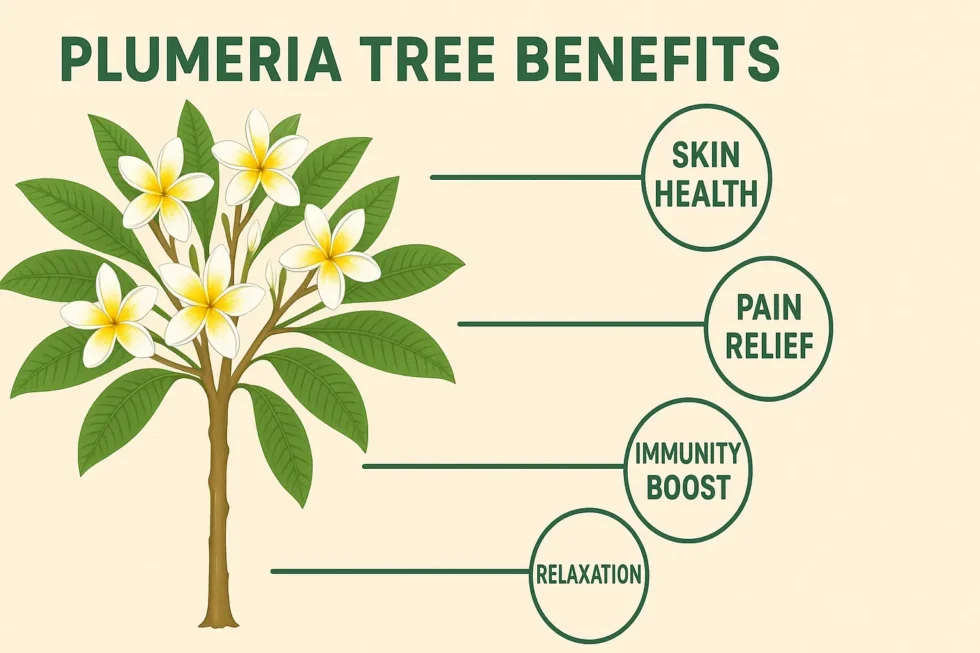
The Plumeria tree, better known as Frangipani, is quite the gem of the tropics! People love it for its amazing fragrance and those delicate, yet bright, flowers. Originally from the warm parts of Central America, the Caribbean, and some areas in South America, this lovely tree has really made its way around the globe, finding homes in tropical and subtropical spots everywhere.
Frangipani Wonders: All About the Plumeria Tree
One of the first things you notice about the Plumeria tree benefits is, of course, its flowers. They come in stunning colors like white, yellow, pink, red, and even combinations of these. It has thick, fleshy branches filled with a milky sap, and its leaves are long, kind of tough, and a bright, healthy green. Beyond just looking beautiful and carrying symbolic weight, the benefits of Plumeria tree is also quite useful. In old-school medicine, folks have been using various parts of the tree, like its bark, leaves, and even sap, to tackle issues such as skin rashes, fevers, and tummy aches.
In Hawaii, for example, people use its lovely flowers to create leis, and these blossoms stand for love, positivity, and a warm welcome.
Types of Plumeria Tree-
Plumeria alba
Plumeria obtusa
Plumeria stenopetala
Plumeria pudica
Plumeria ‘Aztec Gold’
Plumeria ‘California Sunset’
1.Plumeria rubra:
The most common type. It really stands out with its wide range of flower colors, including shades of red, pink, yellow, and white. Plus, its fragrance is quite powerful.
2.Plumeria alba:
Its leaves tend to be more slender compared to others. This beauty is native to the Caribbean and Central America.
3.Plumeria obtusa:
It is called Singapore Plumeria. It has lovely glossy, dark green leaves and produces white flowers with distinctly rounded petals.
4.Plumeria stenopetala:
It is a rarer find. Its flowers have very narrow petals, and interestingly, they release their fragrance at night.
5.Plumeria pudica:
It goes by the charming name Bridal Bouquet.
6.Plumeria ‘Aztec Gold’:
It is a special hybrid variety. It produces large, stunning flowers in a golden-yellow hue, and it smells absolutely wonderful.
7.Plumeria ‘California Sunset’:
It is famous for its striking color blend – a beautiful mix of pink, orange, and yellow. It’s a popular choice for adding color to landscapes.
Also visit-Nature Herb And Holy Basil : Nature’s Miracle Herb for Health
How it use in beauty use-
1. Aromatherapy & Perfumes:
The essential oil from Plumeria is famous for its strong, lovely scent. Also used in perfumes, body mists, and scented oils. Its calming and soothing aroma makes it popular in spa treatments too.
2.Skin Moisturizers:
Plumeria tree benefits are oil is often added to lotions and creams because it helps keep skin hydrated and can even combat signs of getting older. It’s full of antioxidants and works to keep skin looking firm and soft.
3. Hair Care:
You can find Plumeria in hair oils and conditioners. It helps nourish a dry scalp, adds shine to your hair, and leaves behind a lovely, long-lasting floral smell.
4. Bath Products:
You’ll frequently find plumeria in bath bombs, soaps, and shower gels. It gives these items a lovely, tropical vibe and is also known for having calming and stress-relieving properties.
5. Massage Oils:
Plumeria oil is blended with other oils and creates soothing massage mixtures so that it help relieve sore muscles and also enhance the skin’s overall texture.
How Plumeria tree used in Medicine-
| Plant Part Used | Medicinal Use | Application/Benefit | Note/Warning |
|---|---|---|---|
| 🌿 Leaves & Bark | Anti-inflammatory & Pain Relief | Applied as paste or poultice for swelling, sprains, aches | Avoid open wounds; test for skin sensitivity |
| 🌸 Flowers | Antioxidant & Antibacterial Properties | Used in extracts for natural defense & skin care | Needs more clinical validation |
| 🌿 Bark (Decoction) | Fever Reduction & Cold Relief | Taken as herbal tea or decoction | Use under guidance; can be toxic in high doses |
| 🌱 Roots & Bark | Digestive Aid (Mild Laxative) | Traditional remedy for constipation | Risky without medical supervision |
| 🌿 Sap (Latex) | Treatment for Skin Conditions (Ringworm, Scabies, Eczema) | Applied topically in very small amounts | Can irritate skin; mildly toxic if ingested |
| 🌸 Flower Oil | Aromatherapy & Stress Relief | Used in perfumes, massages, sleep and anxiety treatment | Safe when diluted in essential oil blends |
Conclusion-
It’s really important to keep in mind that while these traditional uses show what the plant might be capable of, we don’t have a huge amount of scientific proof yet. And you have to be careful – using parts like the sap or bark the wrong way can actually be harmful. So, if you’re thinking about using Plumeria for medicinal purposes, it’s best to proceed cautiously and, ideally, talk to a qualified expert first.






Sunflower Wonders: Beauty, Science, and Secrets of Nature’s Golden Bloom - Panda Pandi